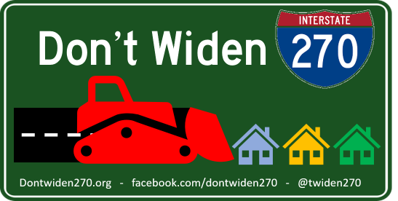You might have seen a reasonable looking petition online recently: “We are tired of sitting in traffic,” it says. “Sign our petition to support Traffic Relief NOW!”
It’s sleight of hand. The sponsoring organization is led by a former spokesman for Larry Hogan and backed by big corporations, contracting companies, and lobbyists pushing the I-495/I-270 P3.
It’s like so many things connected to the toll-lane project – what we’re told and what’s actually happening are not the same. A few examples (you can read more about them after the Action Item):
MDOT insists safety is a toll-lane project priority, but our story, “Four Feet of Pavement and Plastic Stalks” offers evidence to the contrary.
In the name of faux “congestion relief”, MDOT plans to destroy the real congestion relief it’s already brought to lower I-270.
The winning bidder for the I-495/I-270 P3 contract provided unrealistically low construction cost estimates, according to claims made in court by a failed bidder. The judge ruled against MDOT, must review the substance of the challenger’s claims.
Action Item
The fate of the toll-lane project is tied to whoever wins the gubernatorial primaries on June 28th and the general election on November 8th. We want a new governor who will reject the harmful P3 and champion transportation that meets real needs.
According to a smart new Baltimore Sun editorial, the election should “be the final word on whether Marylanders support or oppose” the toll lane project. “Given the project’s various controversies including strong opposition in Montgomery County (including from the majority of its General Assembly delegation)…it really ought to be put to referendum, which is exactly what the governor’s race represents.”
To help clarify your voting choices, jump on the opportunity to hear most of the gubernatorial candidates answer critically important questions – likely including one on the toll-lane project – at back-to-back Climate Forums on Tuesday, March 8 and Wednesday, March 9, 7-8:30 p.m. The events will be streamed on Facebook. Find details, links and candidate line-ups here in Maryland Matters.
Even Comptroller Peter Franchot, the decider who decided to vote for the boondoggle, says he’ll be at the Wednesday forum.
It’s 4 feet of pavement + plastic stalks. MDOT calls this safe??
You know from our last newsletter that MDOT’s proposed toll-lane design takes away the inside shoulder from the free lanes. Unsafe!
Now look at another source of danger in MDOT’s proposal. All that will separate the free lanes from the toll lanes is 4 feet of pavement and a row of plastic stalks (called candlestick posts). The stalks are already deployed on I-495 in Northern Virginia (see the pic and caption below, both from this Federal Highway Administration Report, Sec. 5.3). MDOT is proposing the same “barrier” design for I-270/I-495 and using the same contractor.
The really bad news: the Federal Highway Administration Report says, “Plastic posts will not stop an errant vehicle from crashing through the barrier” (Sec. 1.3).
Figure 48. Photo. The I-495 Express Lanes are operated by a private firm and are separated from the publicly owned and heavily congested general purpose lanes by a 4 foot buffer with a plastic post barrier.
Imagine this configuration on MD’s I-270 and I-495. At rush hour, the free lanes will fill with cars, trucks, and big rigs. Just 4 ft. away, in the sparsely occupied toll lanes, drivers who paid sky-high tolls will be moving faster. Vehicles from either side could plow across the 4 ft. divide because of avoidance maneuvers, inattention, going too fast for conditions, and more (ATSSA: Guardrails and Barriers).
MDOT solved congestion on lower I-270; now it wants to “un-solve” it
MDOT’s P3 program will tear down the highly successful Innovative Congestion Management Project (ICMP) on lower I-270 and replace it with a toll-lane design that removes lanes and is guaranteed to worsen congestion (pp. 18-40).
Since 2017, MDOT’s $132,000,000 ICMP has used roadway and safety improvements and innovative technology to nearly eliminate congestion on I-270 below the northern bottleneck at I-370.
Instead of touting the achievement, MDOT falsely claims lower I-270 is still in dire need of congestion relief. Seven months worth of compelling evidence says otherwise.
Since July 2021, independent daily traffic recording – using screenshots of the traffic overlay on the Google Traffic App during a.m. and p.m. rush hours – shows how well ICMP is working.
| Barring accidents, storms, or roadwork, I-270 below I-370 consistently moves at or above the speed limit (shown as “green” in the image). |  |
 | I-270 north of the I-370 bottleneck consistently shows moderate or severe congestion (shown as "orange" or "red" in the image). |
| And I-495 and I-95, including the locations of Virginia’s toll lanes, consistently show moderate or severe congestion. |  |
There’s no clearer example of the waste and futility of the toll-lane P3 than this planned destruction of a successful program to make room for one that won’t work.
You can read more about the thousands of daily traffic-recording images, and find additional information and links about ICMP here (p. 63-68).
Toll-lane project faces new source of delay
A Montgomery County Circuit Court judge recently ruled against MDOT in an appeal of the toll-lane contract award by a losing bidder. MDOT must now go back and consider the challenge on its merits, not simply on its timing. A headline captures the impact: “Blockbuster Ruling Imperils Hogan’s I-495/I-270 Toll Lanes Timeline.”
Per the Washington Post, the losing bidder claims the Transurban team’s winning proposal “assumed unrealistically low construction costs that could result in massive delays and cost overruns…” If the challenger is right, we know that the money to cover those delays and overruns will come out of taxpayers’ pockets.





